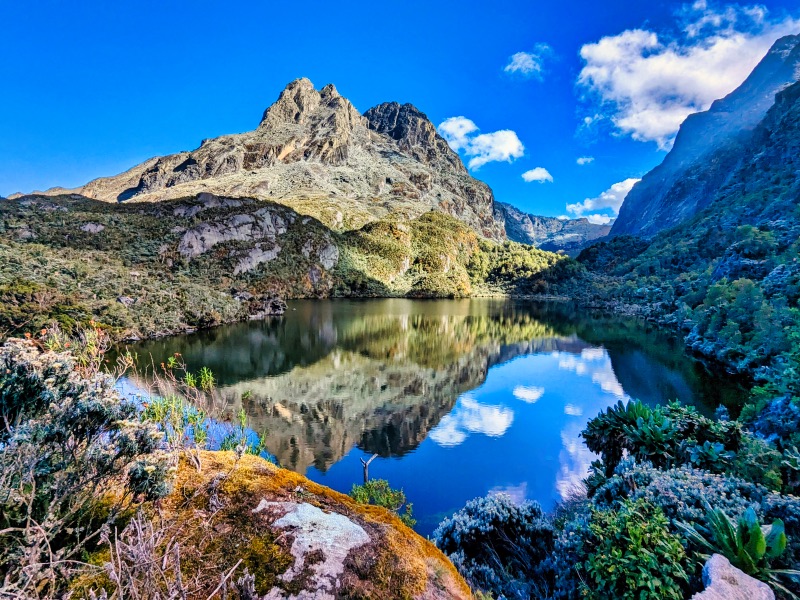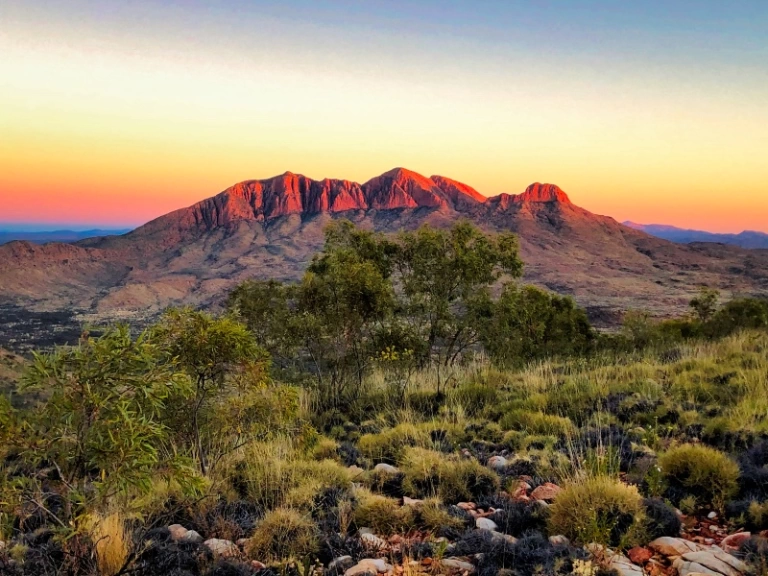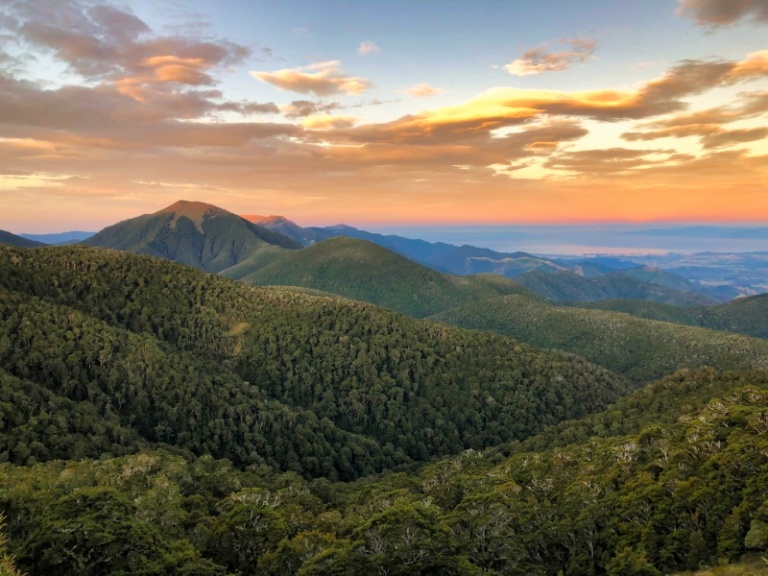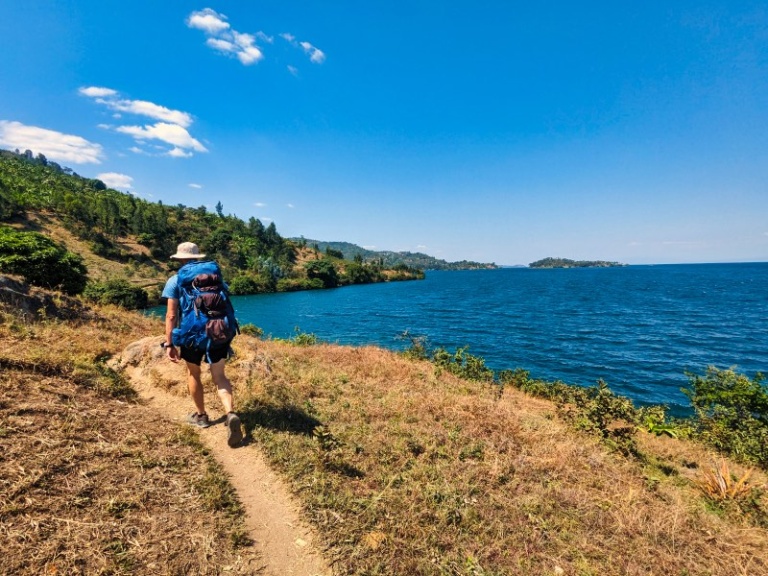The Essential Guide to Trekking the Rwenzori Mountains (2024)
The Rwenzori Mountains are, without a doubt, one of the most magical places on Earth. We’ve hiked all over the world, from Kyrgyzstan to New Zealand to Pakistan, and hiking the Kilembe Trail in the Rwenzori Mountains National Park ranks as one of our top trekking experiences. Seriously. It’s that good.
So move over Kilimanjaro, conquering the Rwenzori Mountains is easily the best hike in Africa.
Want to check out the Rwenzori Mountains for yourself? We don’t blame you! Read on for our complete guide to trekking the Kilembe Trail in the Rwenzori Mountains National Park.
Our epic trek on the Kilembe Trail was supported by Rwenzori Trekking Services. As always, all opinions in this article are completely our own.
Uganda Travel Resources
- Getting there: search for flights to Uganda
- Where to stay: find a guesthouse, hostel or hotel
- Guidebook: pick up a copy of Bradt’s Uganda
- How to get around: rent a car or 4WD
- Travel insurance: get travel insurance for your trip
- Money: get a Wise travel card to save big time in Uganda
- Gear: pick up a Steripen for clean water 24/7
Kilembe Trail: Overview
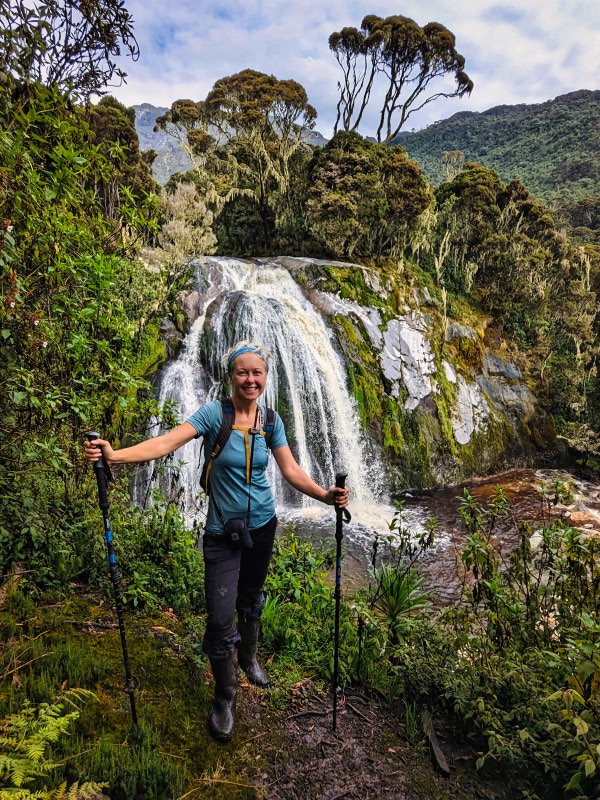
- Location: Rwenzori Mountains National Park, Kasese District, Western Uganda
- Length: 84 km
- Time: 7-8 days
- Season: June to August and December to February
- Gateway city: Kasese or Fort Portal
- Type: Circuit
- Booking Required: Yes
- Sleeping: Huts
- Start: RTS Base Camp, Kilembe
- Finish: RTS Base Camp, Kilembe
- Difficulty: Difficult
- What to expect: Tropical rainforest, bamboo forests, glacial peaks, lots of mud and the most varied scenery to be found in Africa – or quite possibly, the world. Ready for the best hike in Africa?
The Rwenzori Mountains National Park
Located in Western Uganda, along the border with the Democratic Republic of the Congo, the Rwenzori Mountains National Park is one of the most stunning, and varied, places on the planet.
But the park isn’t just beautiful – it’s also huge, measuring almost 1000 square km. That’s a lot of protected space!
Want more epic hiking in Africa? Check out Fish River Canyon in Namibia and the Congo Nile Trail in Rwanda
Inside the park, quite obviously, are the Rwenzori Mountains, a 120 km long and 65 km wide mountain range. The Rwenzori Mountains are the tallest mountain range in Africa and are higher than the Alps in Europe.
Margherita Peak, the highest in the park, is Africa’s third highest peak at 5,109m. Not to be undone, the Rwenzori Mountains National Park also contains Africa’s fourth and fifth highest peaks, Mount Speke and Mount Baker.
The park has some of the most varied scenery we have ever encountered, with tropical rainforests, waterfalls, glaciers, snowfields, lakes galore, and plenty, plenty more. It is easily the best hiking in Africa.
The Kilembe Trail
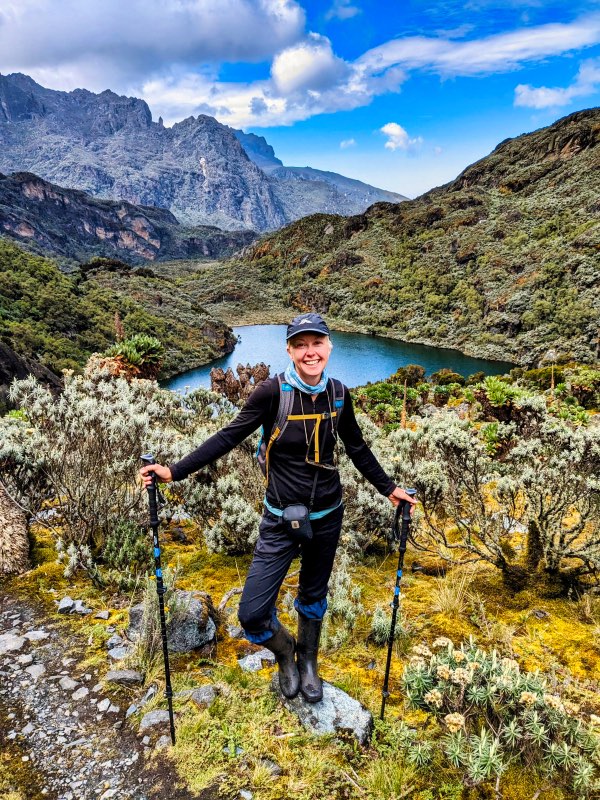
The Kilembe Trail, also known as the Southern Circuit, is one of 3 established trekking routes that lead to Margherita Peak in the spectacular Rwenzori Mountains National Park. The trail is owned and managed by Rwenzori Trekking Services (RTS) and can only be done as a fully-supported hike. It can be hiked over 7-8 days (although 8 days is by far the most common option).
The Kilembe Trail approaches Mount Stanley from the south, passing through all the biodiversity zones the Rwenzori Mountains are famous for: tropical rainforest filled with monkeys and chameleons (and surprisingly, a handful of elephants!), bamboo, heather trees, afro-alpine plateaus and of course, mud and glaciers.
The Kilembe Trail begins just outside the small village of Kilembe and the nearest city is Kasese.
Although, if we’re being honest, Fort Portal is probably a better base to get yourself organised, as there are far better accommodation and restaurant options there.
Heading to South Africa? Check out 12 Epic Cape Town Hikes
Best Time to Hike the Rwenzori Mountains
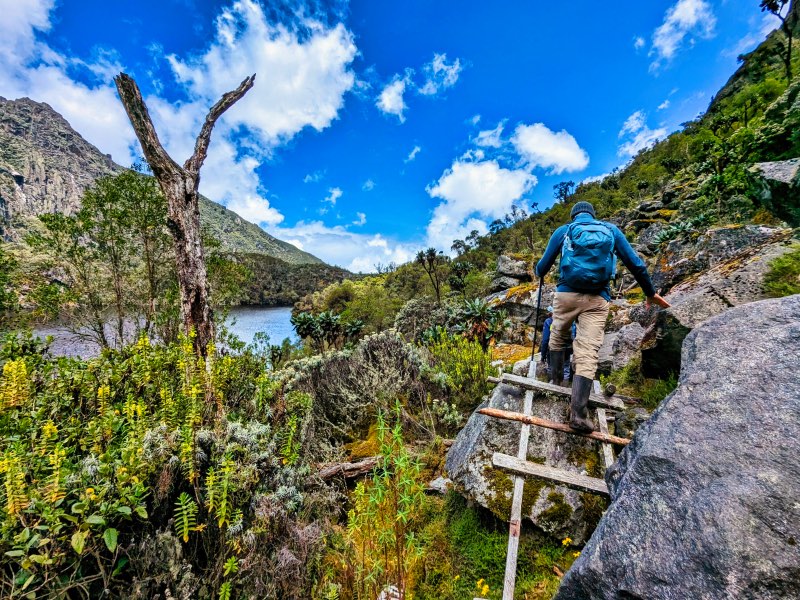
The best time to hike in the Rwenzori Mountains is in January, February, June and July. Both of these times fall within Uganda’s two dry seasons and are when you have the greatest chances of clear, dry days.
Outside of these periods, you can still hike in the Rwenzori Mountains, but you must be prepared for some rain, mist, lots of mud and unpredictable conditions. To give you an idea, we hiked at the end of August and the start of September and had some rain around 4 of the 8 days we were on the Kilembe Trail.
The rainiest month in the Rwenzori Mountains is October and after having spent some time in the region during this month, we do not recommend trekking at this time. Daily rainfall is around 30mm a day, with frequent storms. If you’re determined, give it a go, but just be warned: conditions will be rough.
Read next: 7 Epic Uganda Camping Sites + Essential Tips
How much does it cost to hike the Rwenzori Mountains Kilembe Trail?
We’ll be honest, hiking the Kilembe Trail in the Rwenzori Mountains is not a cheap undertaking. Don’t get us wrong, it’s completely awesome, but it’s very expensive. You have to pay a premium for the best hike in Africa!
The costs for trekking in the Rwenzori Mountains are split into three categories: Rwenzori Trekking Services’ fees, Rwenzori Mountains National Park fees and gratuities.
Rwenzori Trekking Services Fees
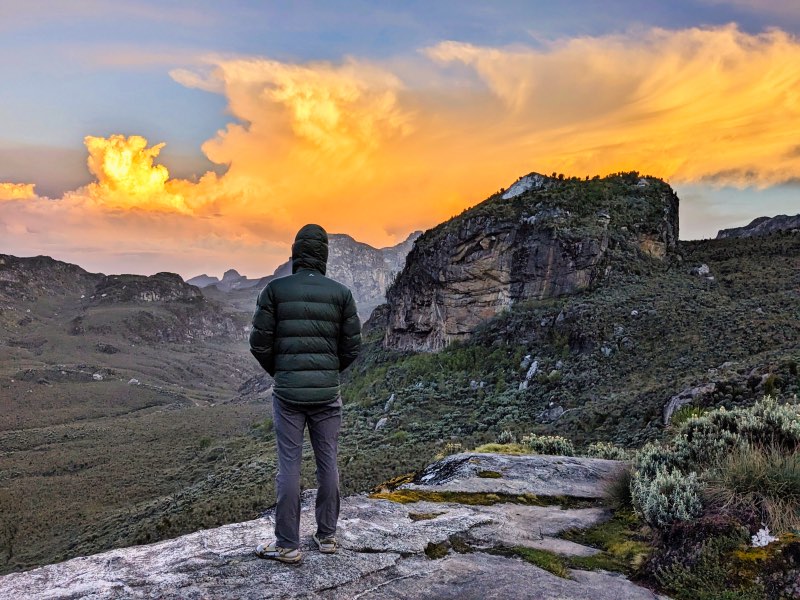
First, there are the fees paid to RTS directly. These fees cover your guides, porters, food, some gear and accommodation on the trail.
A complete 8-day trek to Margherita Peak via the Kilembe Trail currently costs $1490 USD per person for 1 or 2 people or $1410 USD per person for 3 or more people. In January 2024, these prices will rise to $1820 USD per person and $1780 USD per person, respectively.
This fee can be paid via bank transfer to RTS in advance or in cash when you arrive at Base Camp. If you need to make a bank transfer to RTS, we recommend using Wise.
At present, there are no credit card facilities, so don’t plan on flexing your plastic.
Pro tip: if you need to pay cash but want to minimise bank fees, try Centenary Bank. They accept both Visa and Mastercard, allow withdrawals up to 2,000,000 UGX per transaction and do not charge any ATM fees.
Rwenzori Mountains National Park Fees
In addition to what you pay RTS directly, you must also pay an entrance fee of $35 per person per day for entrance into the Rwenzori Mountains National Park. As a saving grace, this fee is calculated on how many nights you spend in the park (rather than days), so for a traditional 8-day trek to Margherita Peak, you pay for 7 nights ($245 USD per person).
This is paid directly at the gate to the Rwenzori Mountains National Park and can be paid in either cash or credit card.
Gratuities
Finally, it is customary to give a gratuity (or tip) to the team at the conclusion of the hike.
This depends on the level of service you received and how happy you were with the experience and is always at your own discretion.
Total Cost for Trekking To Margherita Peak on the Kilembe Trail
Adding it all up, an 8-day trek to Margherita Peak currently costs $1735 USD per person for a group of 1 to 2 people, and $1655 USD per person for a group of 3 or more. This doesn’t include optional tips.
In 2024, these fees will rise to $2065 per person and $2025 per person, depending on group size.
How to Book the Rwenzori Mountains Kilembe Trail
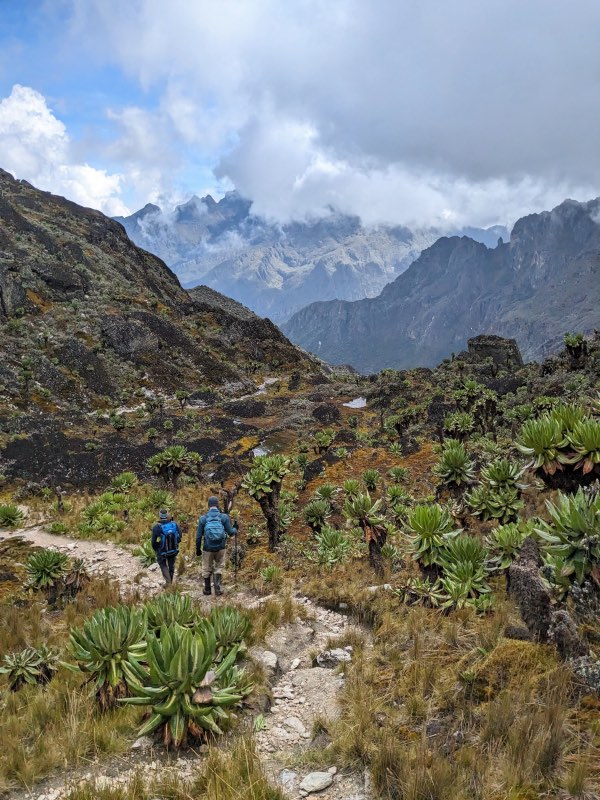
Since hiking the Rwenzori Mountains Kilembe Trail is a big expedition, it must be booked in advance. To do so, contact Rwenzori Trekking Services’ Kampala Office for reservations on either:
- Phone: +256 (0) 774114499;
- WhatsApp: +256 709747700; or
- Email: [email protected]
It’s recommended to reach out to RTS a couple of months in advance, especially if your dates are limited and/or you want a special itinerary designed for you.
Want to get off the beaten track in Uganda? Check out Kapchorwa – Hidden Gem of the Mount Elgon Region
How difficult Is Trekking in the Rwenzori Mountains?
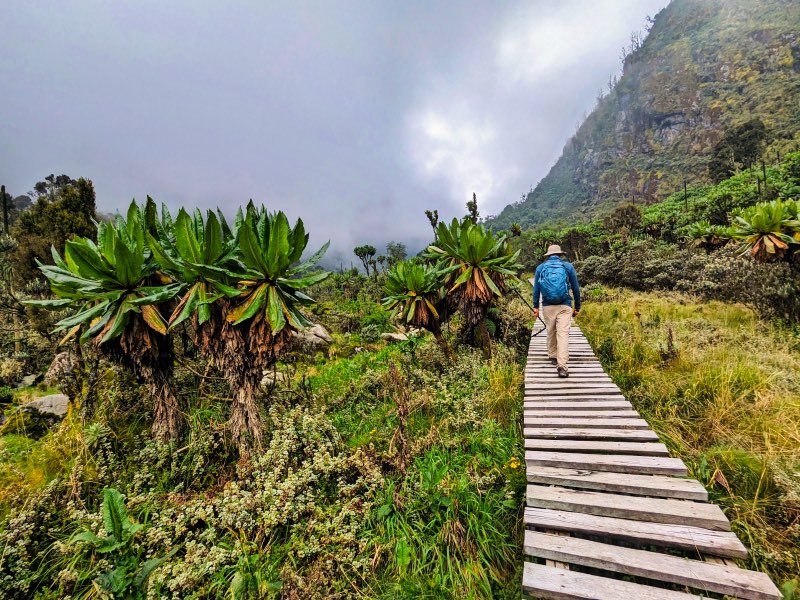
Trekking in the Rwenzori Mountains is very challenging, and indeed, considered some of the most strenuous hiking in Africa. Many people conquer Kilimanjaro, only to find out that Mount Stanley and Margherita Peak are much, much harder. But, if you ask us, it’s the best hike in Africa, so worth every bit of effort.
Interested in more epic hikes around the world? Read about the Ak Suu Traverse in Kyrgyzstan
That said, as always, how difficult the Rwenzori Mountains are for you will depend on a number of factors including your level of fitness, prior trekking experience and reaction to altitude.
If you are fit and with a good level of trekking experience, then it will be a fun and moderately challenging experience. If you haven’t trekked a lot or are new to high-altitude trekking, then you will find it very challenging.
We have done many multiple-day treks before, many at high altitude, and always carrying our own gear. For this reason, we personally found the Kilembe Trail moderately difficult.
The specific challenges on the Kilembe Trail include:
- Steep and slippery trails;
- Difficult conditions (i.e., mud and slippery planks);
- Unpredictable and fast-changing weather; and
- High altitude.
What to expect on the Kilembe Trail in the Rwenzori Mountains
Before Departure
The night before you set off into the Rwenzori Mountains, you can either stay in Kasese, Fort Portal or at RTS Base Camp (Trekkers Hostel). Obviously, if you stay at Base Camp the night before, you’ll save a lot of time in the morning.
When you get to Base Camp, you’ll meet your guides who will give you a briefing. They’ll explain the specific challenges in the Rwenzori Mountains (altitude, weather, conditions), ask about your experience and give an overview of what to expect.
Then it’s gear time. Your guides will outline the essential gear for the Kilembe Trail, ask what you have and get you to show it to them so that they can inspect your gear to make sure it’s good enough. For example, Zandy’s trail runners weren’t sufficient for the summit and was provided with a pair of mountaineering boots.
You try on rubber boots, which are absolutely essential and included in your fees. All other technical gear (helmets, ropes, harnesses and crampons) is provided at no additional cost.
Then, they’ll go through the map on the wall, explaining the route, what each day looks like and the altitude each day. It’s all very comprehensive and professional!
Camps on the Kilembe Trail

There are six designated camps on the Kilembe Trail, all with multiple huts for sleeping and dining. After having trekked extensively using the New Zealand hut system, we were shocked to see so many different huts at each camp!
Each camp has a separate hut for dining and except for the first two camps, all of the dining huts have stoves. This is great for drying your clothes (and yourself) after a big rain!
The sleeping huts consist of either bunks or sometimes, double beds. You’ll need to bring your own sleeping bag and be sure to bring a warm one!
Pro tip: Invest in a blow-up pillow. Your hikes will never be the same.
The toilets at camp are all long-drop squatters, which are cleaned regularly.
There are lots of little touches at each camp, such as handwashing stations with soap. Talk about luxury!
Every night after dinner, there is a briefing with your guides who tell you what to expect for the next day and to make a departure plan.
Food on the Kilembe Trail
As the Kilembe Trail is a fully-supported hike, all of your meals are provided by RTS. The meals are plentiful and considering you’re in a remote part of the world, quite varied.
We found that the staff put a lot of effort into meal time and it shows – we always went to bed full! You will be well-nourished as you conquer the best hike in Africa.
Outside of meals, we recommend bringing some of your favourite snacks. Lollies, or candies, are great, but our favourite tip is to put in some savoury snacks, as people often get sick of sweet flavours after so many days.
Weather in the Rwenzori Mountains
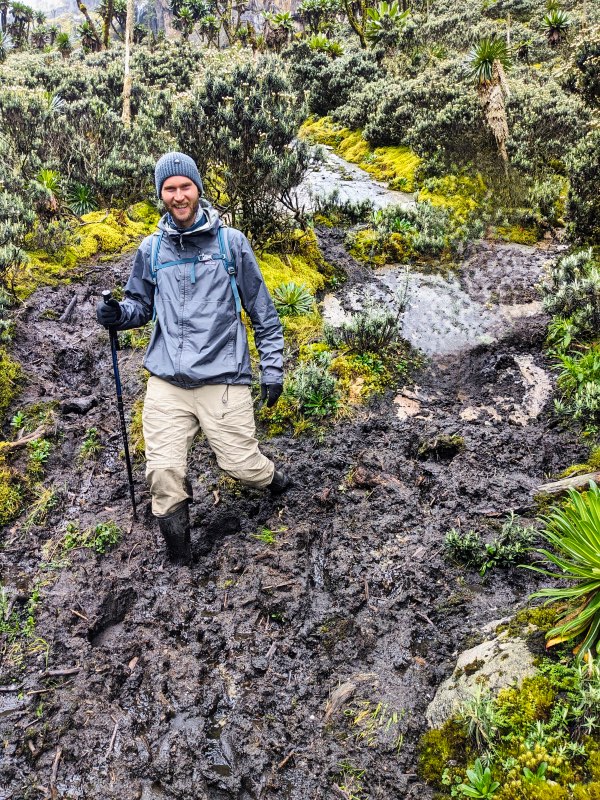
Mountain weather is always unpredictable, but the Rwenzori Mountains take it to the next level. In all of our hiking all around the world, we have never seen weather like we did in the Rwenzori Mountains. It is absolutely crazy just how fast the weather can change.
Even if you are hiking in the middle of the dry season (January, February, June and July), you must still be prepared for rain and wind.
As a general rule, expect heat (for the lower sections), cold (for higher altitudes), wind, snow and rain. Be prepared for everything! Literally. This is hiking in Africa to the extreme.
Safety in the Rwenzori Mountains
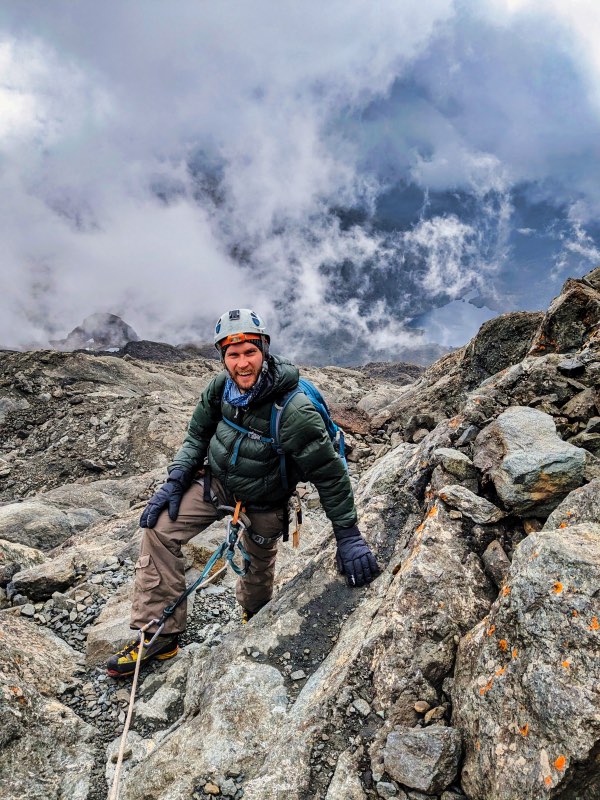
Trekking in the Rwenzori Mountains is a serious endeavour and as with all remote mountains, brings a certain element of risk.
Altitude sickness is a major concern and something that your guides will monitor. If you experience any altitude sickness symptoms (shortness of breath, dizziness and headaches) inform your guides immediately.
Injury, of course, is another risk. The trail can be quite slippery and hazardous, so do take your time. We also recommend paying special attention on the boardwalks – we both had falls here!
Travel insurance, as always, is essential. If something goes wrong, you want to be covered. Our preference is SafetyWing. Trust us, we’ve used a lot of travel insurance and they really are the best.
Mobile Reception and Electronics in the Rwenzori Mountains
There is little to no reception in the Rwenzori Mountains, so make sure to let your friends and family know you’re going hiking in Africa and taking a digital detox.
We recommend bringing a power bank to keep your devices fully juiced. This can be charged at Hunwick’s Camp, which has a strong and reliable source of power.
Porters on the Kilembe Trail
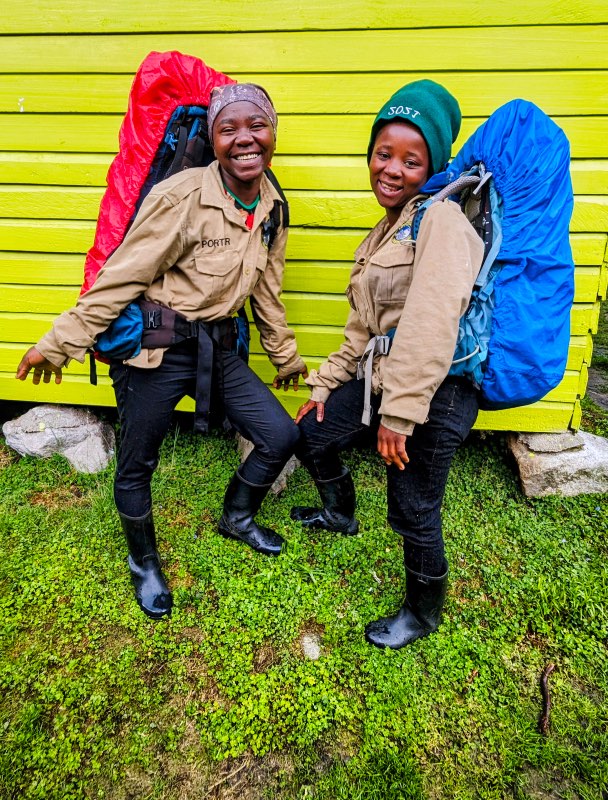
As all hiking up to Mount Stanley and Margherita Peak is fully supported, that means a full team of porters to accompany you. If you’re used to self-supported hiking, like us, this will be quite an unusual experience. It’s pretty normal for hiking in Africa.
The porters arrive on the morning of departure into the Rwenzori Mountains. Throughout the hike up to Mount Stanley, your porter will carry your bag for you, up to 20 kg. Each day, you’ll pack it up and provide it to your porter for the day and you will just carry what you need in a day pack.
We didn’t love this system, but understand they’re working on an alternative.
As a side note, RTS employs women porters, which we think is super rad. Yay!
Kilembe Trail Sections
Section 1: Base Camp (1450m) to Sine Hut (2598m)
- Distance: 11 km
- Difficulty: Moderate
- Time: 5 – 7 hours
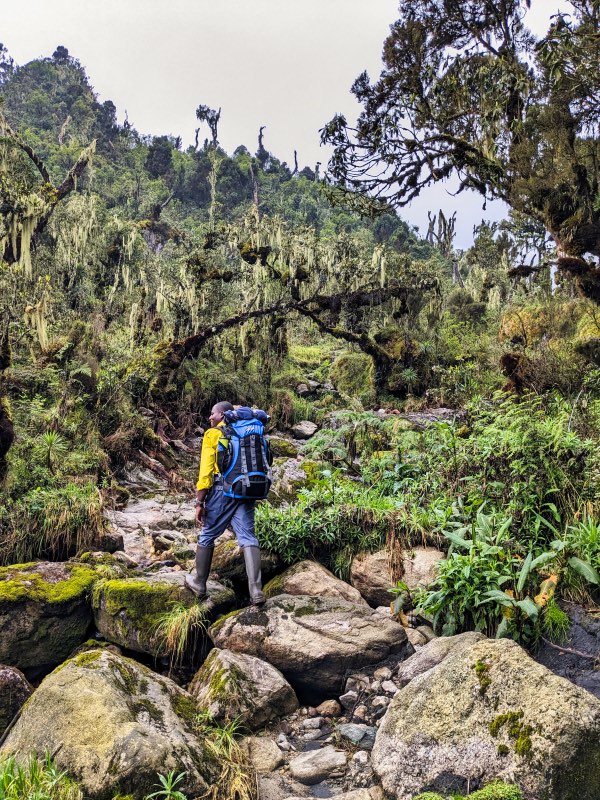
The first section of the Kilembe Trail consists entirely of tropical rainforest.
What does this mean? It’s very humid and you should expect to sweat a lot! There’s also a lot of moss and ferns and for the fauna, birds and butterflies. If you’re lucky, you may also spot some monkeys and a chameleon or two. How good is hiking in Africa?
Whilst this section is all rainforest, unlike other rainforest hikes (ahem, Duwili Ella), it’s very open and often traverses the edge of the rainforest, so you still get beautiful views of the Rwenzori Mountains National Park.
The gradient is steep, but the trail is very wide and easy to walk on. Overall, the trail on this section of the Kilembe Trail is very well maintained and one of the best we’ve ever come across – not just hiking in Africa, but hiking in general. Our guides told us they maintain it every 2 weeks and you could tell.
Sine Hut is a nice camp, with long drop toilets, lighting and a pleasant balcony with tables to relax on.
Note: on the 7-day Kilembe Trail, hikers proceed on to Kalama Camp.
Section 2: Sine Hut (2598m) to Mutinda Camp (3588m)
- Distance: 9 km
- Difficulty: Moderate
- Time: 5 – 6 hours
Section 2 on the Kilembe Trail has you steadily climbing all day.
The trail starts off at the edge of the rainforest, briefly goes through the bamboo forest and then enters the heather zone.
One of this section’s highlights is the magnificent Lobelia Garden, a wide valley filled with beautiful lobelia plants. This is one of the reasons we rate this as the best hike in Africa. The landscape feels extraordinary and like so much of the Rwenzori Mountains experience, changes drastically before your eyes.
Once you get to Mutinda Camp, if you’re feeling eager, you can push for a climb up to the Mutinda Lookout (3 km return, +/- 400m). It’s super steep and a big climb, but offers exceptional views of the valley. It’s also good for acclimatisation.
Note: on the 7-day Kilembe Trail, hikers proceed to Bugata Camp.
Section 3: Mutinda Camp (3588m) to Bugata Camp (4062m)
- Distance: 5 km
- Difficulty: Moderate (with some challenging sections)
- Time: 4 – 5 hours
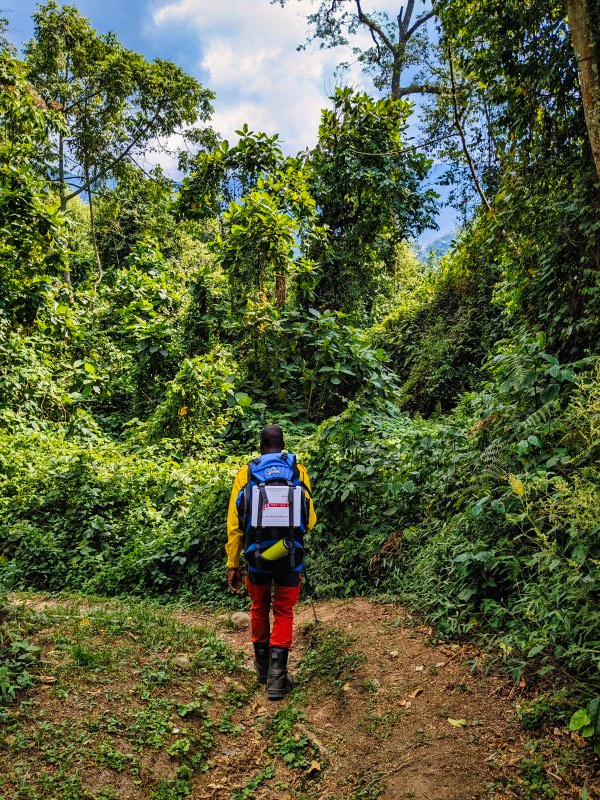
Today is when you first get to experience the infamous Rwenzori Mountains mud!
Although this section of the Kilembe Trail is only 5 km, expect it to take upwards of 4 hours – it’s slow going in the mud. It’s also when most people begin to experience the slowing effects of altitude.
In this section, you enter the afro-alpine zone. Because this zone is so unique to hiking in Africa, we really loved it. Like every day in the Rwenzori Mountains, it’s very, very beautiful. The peaks become more pronounced and the trees begin to thin. The vegetation becomes almost tussock-like.
Expect some picturesque boardwalks to help you through the worst of the bog. Watch your step!
Bugata Camp is very scenic and was probably our favourite camp. It’s set high up on rocks within a mountain bowl overlooking Lake Bugata.
Section 4: Bugata Camp (4062m) to Hunwicks Camp (3974m)
- Distance: 8 km
- Difficulty: Challenging
- Time: 5 – 9 hours
Section 4 begins with a steady climb to Bamwanjara Pass (4450m). As you start approaching the pass, the mystical celestial trees slowly start appearing.
If it’s clear, the views from Bamwanjara Pass are excellent and you should be able to see Mount Stanley and well into the DRC.
Once you descend the pass (steep but steady), a big celestial forest appears. It feels very whimsical, like being in a Dr Seuss book. Another reason why this is one of the best hikes in Africa.
When you bottom out, the trail is very flat for a nice, short reprieve. You’ll walk adjacent to the Kachope Lakes, one of which has a nice shelter for your lunch break.
After passing the lakes, it’s a very steep, narrow and slippery descent. Be careful here!
The day finishes with a 200m climb to camp.
Hunwicks Camp is very idyllic, surrounded by mountains – Mount Stanley to the left and Mount Baker right in front.
Note: the solar power at Hunwicks Camp is strong enough to charge any devices you have (i.e., a power bank).
Section 5: Hunwicks Camp (3974m) to Margherita Camp (4495m)
- Distance: 5 km
- Difficulty: Moderate to challenging
- Time: 3 – 5 hours
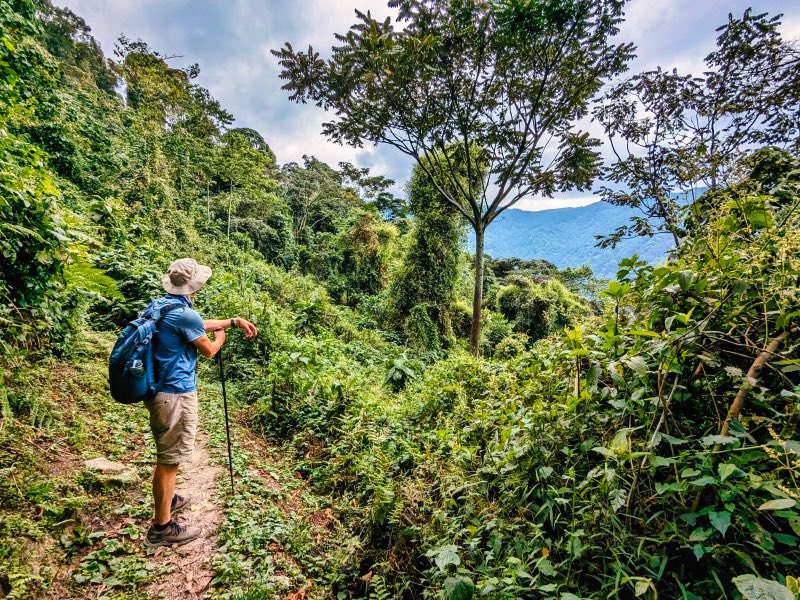
Section 5 on the Kilembe Trail begins by descending from camp to the valley, where there’s a nice boardwalk. Be careful on this boardwalk – both of us had unfortunate falls between the planks here!
The first lake, Lower Kitandara, is really, really stunning. If you’re lucky and it’s clear, there’s an epic reflection of Mount Stanley in it.
After a very short ascent, you reach Upper Kitandara Lake. You then start making your way towards Scott Elliot Pass (4338m).
There’s a section of boulder hopping – about 10 – 20 minutes. Take in the views of the mountains on all sides, plus the views of the lakes behind you.
When you hit Scott Elliot Pass, you begin ascending Mount Stanley. Congrats! There’s a short, flat section, then about 180m ascent to Margherita Camp.
Margherita Camp is cute and simple. When it clears, there are nice views of some of the other peaks on Mount Stanley.
The afternoon is spent learning the skills you’ll need to summit. Your trusted guides will teach you how to use ropes to go up and down and how to put on your crampons. It’s a lot of fun!
Then it’s an early dinner and early to bed!
Section 6: Margherita Camp (4495m) to Margherita Peak (5109m) and then back down to Hunwicks Camp (3974m)
Average Times:
- Margherita Camp to Margherita Peak: 4 – 6 hours
- Margherita Peak to Margherita Camp: 4 – 5 hours
- Margherita Camp to Hunwicks Camp: 3 – 4 hours
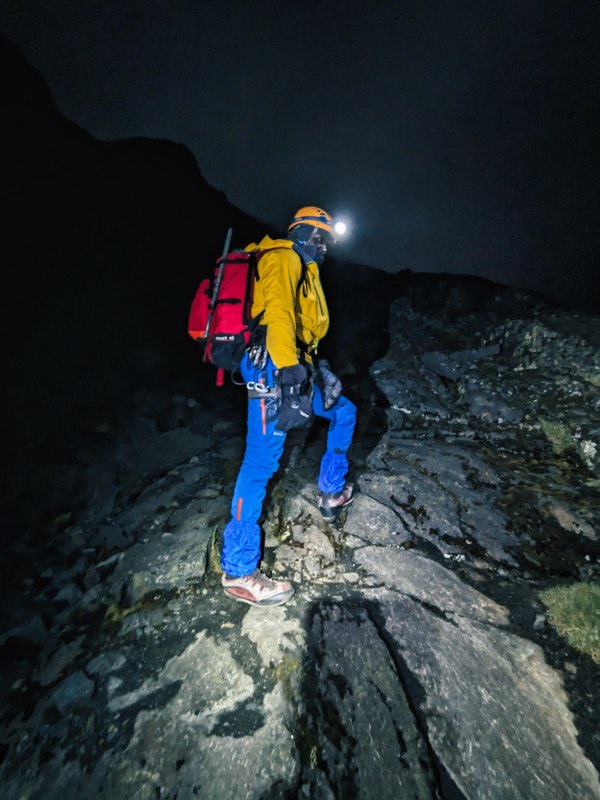
Prepare yourself, today is a BIG day! It’s also the most challenging day on the Kilembe Trail.
First up, it’s an early start to the day. Breakfast is served around 2:00 am and you should expect to head out around 2:30 am.
Sunrise is around 6:30 am, so you will be walking/climbing in the dark for around 4 hours.
Important: make sure that your headlamp has at least 4 hours’ capacity so that you have light for the entire climb before sunrise.
If it’s your first time mountaineering, it can take a bit of time to figure out all the new skills you’ve learned. Switching gear eats up a lot of time (ropes, taking crampons in and off, etc.). It’s also heavy walking with the extra gear on. You’ll find that you go a lot slower than you’re used to.
To summit Mount Stanley and reach Margherita Peak, there are 5 fixed ropes to use and 2 glaciers to cross.
Just after you pass Elena Camp, you reach the first fixed rope. It’s very steep and similar to rock climbing. Take your time.
The first glacier is Stanley Glacier. It’s not bad to walk across and relatively easy.
The second glacier is Margherita Glacier. This girl is gnarly. It’s super steep, long and tiring. It’s around 1.3 km of distance, with 200m of elevation gain (from 4900m to 5100m). But, it’s an incredible experience.
Once you’ve crossed Margherita Glacier, the final push on Mount Stanley is a scramble up Margherita Peak and then bang! You’re at the top and it feels amazing.
Once you return to Margherita Camp, you’ll eat lunch and have a rest. Then, you have to walk back down to Hunwicks. It’s a tiring day – be prepared!
Tips for summiting Margherita Peak
- It’s difficult to go to the toilet with gear on (plus it’s really cold). Plan ahead.
- It’s cold in general. Wear lots of layers.
- I wore on my top:
- A merino base layer, merino fleece, down jacket, rain jacket, 2 x gloves (1 x merino liners, 1 x snow gloves) and a beanie.
- On my bottom:
- Bamboo leggings, trekking pants, rain pants, 2 x socks (1x hiking, 1x thick pair).
- I wore on my top:
- Use lots of lip balm! The wind and cold will destroy your lips otherwise.
- The combination of the gradient, the dark and the altitude are challenging. Take your time and take breaks if needed.
- Bring some sugary treats to help you push for the summit of Mount Stanley.
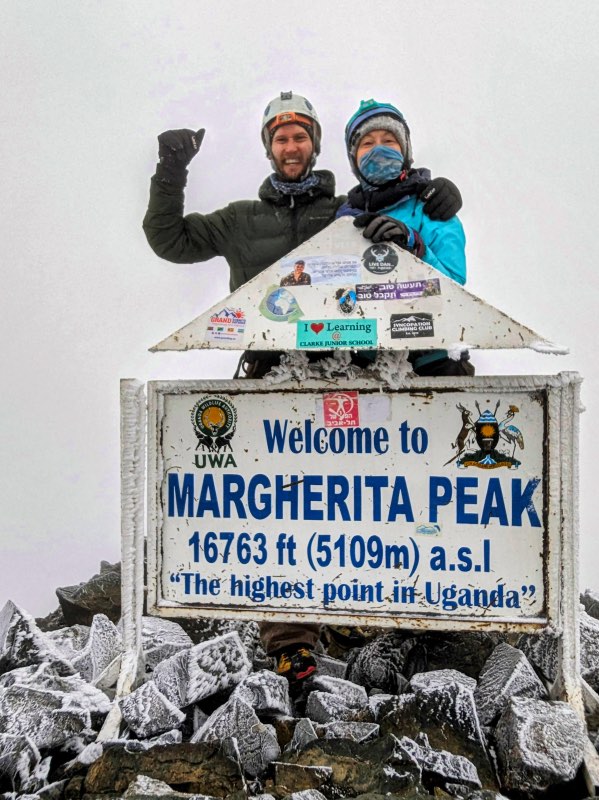
Section 7: Hunwicks Camp (3974m) to Kiharo Camp (3433m)
- Distance: 16 km (w/o a summit of Weissman’s Peak)
- Difficulty: Challenging
- Time: 8 – 12 hours
Section 7 is by far the muddiest day on the whole Kilembe Trail. The mud is very, very, very deep. Even in the heart of the dry season, this section is still muddy as hell.
It’s another long and tiring section, but again, the scenery changes and is beautiful.
If you opt for a summit of Weissman’s Peak, you’ll be treated to some really cool alpine scenery. Up near the top, there’s a beautiful unnamed lake, with cliffs dropping straight into the water.
Then it’s a steep drop down!
Section 8: Kiharo Camp (3933m) to Kilembe Base Camp
- Distance: 17.5 km
- Difficulty: Moderate
- Time: 6 – 8 hours
On the final section on the Kilembe Trail in the Rwenzori Mountains, you lose a lot of elevation in a relatively short distance. You’re also treated to a series of 4 beautiful waterfalls.
Our favourite was the first, Katherine Falls. The second waterfall, Nyamwamba Falls, is particularly good for swimming – if you can brave the cold.
After lunch at Forest View, you can change back to your hiking boots. Goodbye, mud!
It’s then a fast drop of 600m until you hit Nyamwamba Hut. It’s pretty steep and the trail can be quite slippery, so take care. We both had some big falls.
Then the trail levels out and it’s a pretty gentle walk back to the park hut, where you say goodbye to the magical Rwenzori Mountains National Park.
Kilembe Trail: 7 or 8 Days?
Most people hike the Kilembe Trail in 8 days, however, if you are fit and experienced, it can be done in 7.
Other Options for Hiking in the Rwenzori Mountains

The Rwenzori Mountains are so beautiful, and so special, that even if you can’t budget the big trip up to Mount Stanley and Margherita Peak, it’s still worth doing a smaller loop.
There are multiple options to choose from in the Rwenzori Mountains National Park, such as a four-day trek to Mutinda Lookout, or a five-day trek to Weissman’s Peak.
Undoubtedly, Margherita Peak is cool, but the Rwenzori Mountains are so much more than just one mountain.
What to Pack for the Rwenzori Mountains
In general, we packed a bit more for the Rwenzori Mountains than we would for a normal hike of the same length. Due to the conditions (i.e., mud!) and the weather (i.e., rain!) we found it very useful to bring spare clothing and some extra gear.
Important: you can hire lots of gear that you will need from RTS. We rented waterproof gloves, waterproof pants and gaiters. We found them all to be very good quality and each item cost $10 USD.
Packing tips
- If you have two pairs of trekking pants, it’s useful to bring both. They will get wet and muddy and it’s nice to have an alternate option.
- Bring lots of socks. This way, you can replace them if they get wet and still have a warm, fresh pair to wear at camp. You’ll also need one very warm pair for summit day.
- Bring lots of ziplock bags. They’re useful not only for keeping things dry, but also for segregating wet and muddy gear in your bag.
- Bring a small bottle of hand lotion. RTS provides hand-washing stations (which are a blessing!), but the soap, cold and altitude can do a number on your hands.
- Use trekking poles.
Essential gear
Whilst all the gear we outline below is important, here are a few items that are ABSOLUTELY essential.
- Dry bags
- Water bottle
- Hiking poles
- Headlamp
- Waterproof gloves
- Rain jacket
- Warm jacket
- Good boots
- Raincover for backpack
What We Packed For The Rwenzori Mountains
Women’s Clothing
- Hiking boots
- Hiking pants
- Hiking top
- Hiking tank top
- Long sleeve hiking shirt
- Hiking shorts
- Merino underwear
- Sports bra
- Lightweight Merino socks (I’m a fan of wearing two pairs when hiking)
- Warm socks to wear at camp
- Bamboo leggings
- Merino base layer
- Fleece
- Down jacket
- Rain jacket
- Gloves
- Beanie / Toque
- Thermal top
- Thermal leggings
- Waterproof sandals
- Sunglasses
- Hat
- Buff
Men’s Clothing
- Hiking boots
- Hiking pants/shorts
- Sports t-shirt
- Merino underwear
- Lightweight Merino socks (also a fan of the double socks)
- Fleece
- Thermal top
- Thermal bottoms
- Down jacket
- Gloves
- Beanie / Toque
- Waterproof sandals
- Sunglasses
- Buff
- Hat (full-brimmed)
Other Gear
- Blow up pillow
- Sleeping bag
- Waterproof compression bag (for the sleeping bag)
- Stuff sack (for keeping clothes in while hiking)
- Steripen Ultra Rechargeable Portable UV
- Hand sanitizer
Personal
- Eye mask
- Ear plugs
- Toothbrush
- Biodegradable toothpaste
- Deodorant paste (decanted into a small container)
- Blister first aid kit
- First aid kit
- Sunscreen
- Lip balm with SPF
- Book / kindle
- Games to play at camp – deck of cards, or our favourite, Yahtzee
Electronics
- Phone and charging cables
- Power bank and/or solar panel
- Camera and/or GoPro plus charging cords
Where to stay in Fort Portal Before or After The Hike
Budget
Mid-range
High-end
Disclaimer: This post contains affiliate links. This means that if you buy or book anything through them, we’ll earn a small commission at no extra cost to you. This helps us run this website and create comprehensive guides to help you get off the beaten track. We only recommend products and/or services that we use ourselves and trust.

